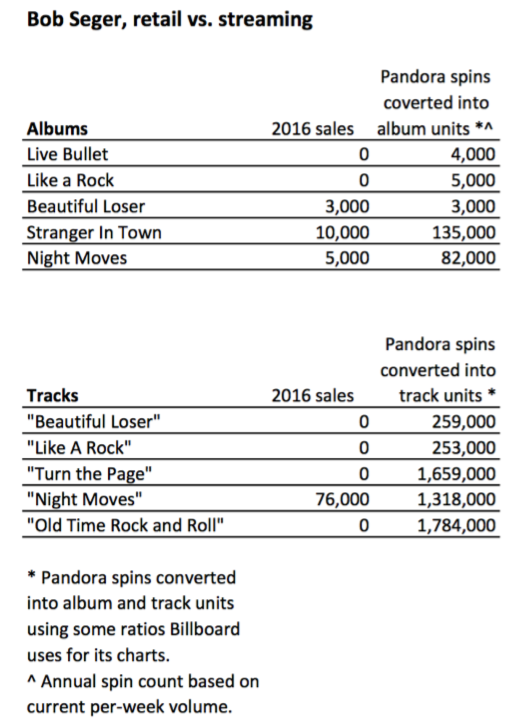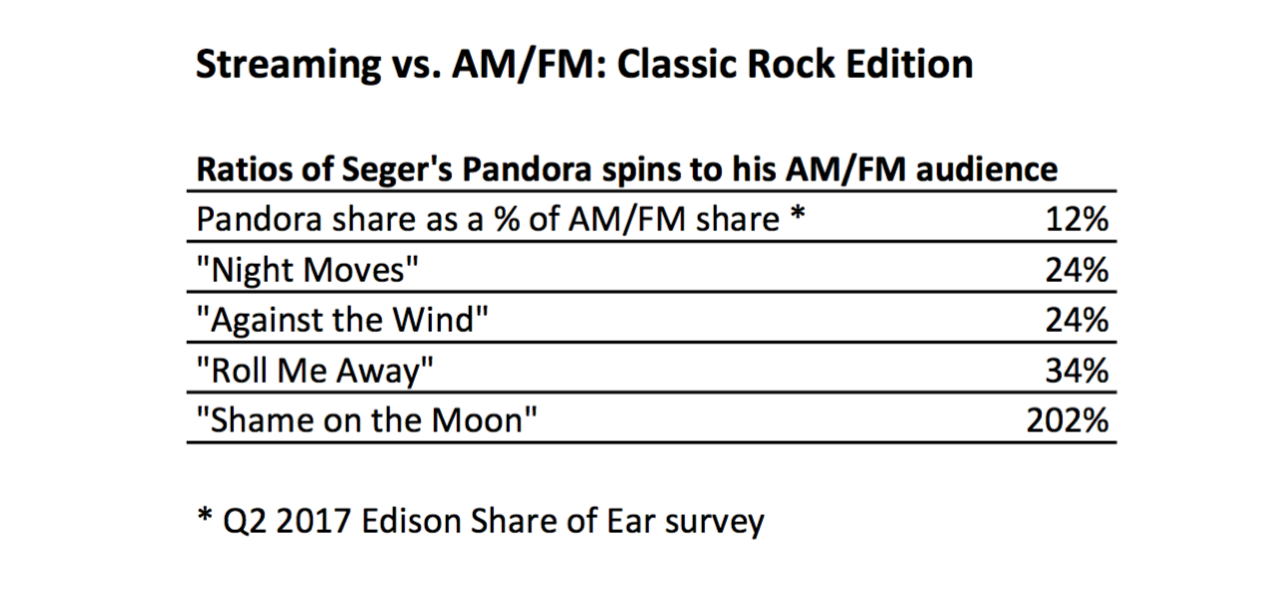In the case of artist Bob Seger, retail and plays on AM/FM radio are not sufficient for fans, and streaming provides a better way to match fans with the music they might enjoy. Here we look at some of Seger’s numbers to see how streaming has allowed him to access a broader scope of listeners.
___________________________
Guest post by Glenn Peoples, Music Insights and Analytics at Pandora, on Medium
Streaming gives people what they want. Vast catalogs, immediate access, and personalized recommendations are features not available from legacy markets. Brick-and-mortar retail and AM/FM won’t always reflect what people want to hear. Not even digital retailers can provide the best matches between music fan and music recording. As noted by economist Tyler Cowen, streaming services excel at reducing search time and matching a particular good with the right customer. If Tower Records was a singles bar, and digital retail was speed-dating, streaming would be Match.com, a place where people spend less time and have the best odds of finding music they’ll love.
Bob Seger is a perfect case in point. The legendary Detroit rocker has a new album out today, I Knew You When, and a catalog of beloved rock and roll classics: “Old Time Rock and Roll,” “Turn the Page,” “Against the Wind,” “Night Moves” and dozens more in his prolific career. If you listened to album-oriented rock radio in the late ’70s or early ’80s, you heard Bob Seger’s throaty howls and stirring croons. He was a Midwest alternative to the East Coast’s Bruce Springsteen. “New Jersey’s blue-collar culture plainly inspired Bruce’s lyrics, but Seger was more mass appeal lyrically with pop sensibilities,” explained Ron Nenni, director of music programming at Pandora.
[Pandora has three new Seger-related items: the Bob Seger A to Z playlist, the Bob Seger and Friends playlist, and the Bob Seger and friends mixtape.]
Seger’s catalog is deep — 18 studio albums (including his newest) and two live albums with tens of top 40 hits and a handful inside the top 10. But retail hasn’t been meeting consumer demand for Seger’s music. Many albums are frustratingly out of print. As Tim Quick (ex-Google Music, ex-Rhapsody) described in his novella-length article about Seger’s catalog, prices for used copies of his out-of-print early albums have become exorbitant. A good condition LP of his first album, Ramblin’ Gamblin’ Man, goes for a reasonable $14 or $15 while a used CD can fetch $22 and a used cassette can cost $30 or more. A used copy of Mongrel can be found for $15 to $20.
Not to sound like a broken record — read this and this and this — but streaming is best able to satisfy what people want to hear. Music retail comes closer but misses the mark. Whatever brick-and-mortar stores exist carry a limited number of titles, and mass merchants have been steadily decreasing the shelf space dedicated to CDs (although the LP has appeared in lifestyle retailers American Apparel and, for a time, Whole Foods stores). Digital retail can carry only whatever titles are in print.

To see how Seger’s streaming volume compares to his retail sales, I compared five albums’ Pandora spins to their 2016 sales (from Nielsen Music). For clarification, this analysis examines U.S. retail sales only and spins only on Pandora, not the overall U.S. streaming market.
Retail sales of Seger’s catalog is dwarfed by his streaming numbers. (In the music industry, the term catalog refers to a title released more than 18 months ago. Anything older than three years is tagged as deep catalog.) Stranger In Town isn’t in the league of all-time great catalog titles such as Bob Marley & the Wailers’ Legend (insane sales) or The Eagles’ Greatest Hits ’71–75(also insane sales), but it registers some sales. Other albums have lower or no sales. There’s an obvious disconnect here between Seger’s sales and Pandora spins. If Pandora’s streams are converted into album units — using the 1,500 streams-to-1 album ratio Billboard uses for its charts — Stranger In Town has the spin equivalent of 135,000 units (and that’s just Pandora). Live Bullet, a breakthrough album that’s out of print, gets 4,000 albums worth of spins at Pandora each year.
AM/FM radio is also failing to meet the demand for Seger’s music. Classic rock stations, which account for 11.2 percent of U.S. radio listening, according to the Radio Advertising Bureau, still play Seger’s long list of classics. So do other formats (classic hits, adult hits, and adult contemporary stations), as longtime Seger manager Punch Andrews noted following Quirk’s article. Even so, his Nielsen BDS radio audience last week was 710,000 listeners, according to Seger’s Next Big Sound page, a surprisingly low figure given his former reign as a king of album-oriented rock of the ’70s and ’80s. His Pandora audience was over seven times that.
What AM/FM program director would delve deep into Seger’s catalog? Classic rock stations are geared toward people who grew up on rock music of the ’60s, ’70s, and ’80s: Jimi Hendrix, Led Zeppelin, Bruce Springsteen, Kansas, Heart, Rolling Stones, Boston, Rush, AC/DC, and Fleetwood Mac are among the most commonly heard artists. They play the well-known tracks aimed at the 45–64 age group while attracting some younger listeners with a sprinkling of bands like Nirvana, Pearl Jam, Guns N’ Roses and Soundgarden.
Radio, by its very nature, can give most people a fraction of what they want. A classic rock station is likely to play “Old Time Rock and Roll,” one of Seger’s most popular song on Pandora and an eternal classic thanks to a half-dressed Tom Cruise’s lip-synced performance in the ’80s film Risky Business. Two more Pandora favorites, “Night Moves” and “Against the Wind,” get consistent radio play. “Shame on the Moon,” from The Distance album, gets surprisingly few AM/FM spins even though it was a well-rounded chart performer in 1983: #1 on the Adult Contemporary chart, #2 on the Billboard Hot 100, and #15 on Hot Country Songs.

To compare Seger’s Pandora audience to his AM/FM audience, I first referred to data from Edison Research to find a benchmark. Edison’s “Share of Ear” survey for Q2 2017 shows Pandora’s share of audio listening (radio, CDs, podcasts, etc.) was 12 percent of AM/FM’s share. Next, I looked up Pandora and AM/FM audiences over the last 12 months for “Night Moves,” “Against the Wind,” “Roll Me Away,” and “Shame on the Moon.” For any song, a ratio above the 12 percent benchmark suggests Pandora is better than AM/FM radio at meeting demand for the song. Pandora spins of his two most popular Pandora songs, “Night Moves” and “Against the Wind,” were 24 percent their AM/FM audiences—twice the benchmark. For “Roll Me Away” it was 34 percent. For “Shame on the Moon,” Pandora spins were 202 percent of AM/FM’s audience (over twice the audience, in other words).
Streaming is able to satisfy demand for both volume and diversity of listening. “Night Moves” will always put up big numbers. But even a tune like “Boomtown Blues” from The Distance, with a chugging guitar riff that starts as a dead-ringer for Heart’s “Barracuda,” gets spins on Pandora. So does “Ship of Fools,” a beautiful, country-inspired tune recorded with the legendary Muscle Shoals Rhythm Section; just the supple guitar playing of Jimmy Johnson, a co-founder of the Muscle Shoals Sound Studios, makes the song a must-hear. Long-time Seger fans will know Live Bullet is filled with incredible but lesser-known blues-rock tracks. “Get Out of Denver,” the leadoff song from his 1975 album Seven, is a scorching boogie that Chuck Berry would have been proud to write. Not coincidentally, the next song, and the Live Bullet closer, is a medley of Berry’s “Let It Rock” and “Little Queenie.” Pandora listeners have been deep diving and enjoying these songs for years.
Access is everything in the digital era. By some accounts, 49 million Americans have tried dating services, and some are seeing results. Twenty percent of committed relationships and 17 percent of marriages are said to have started online. Singles bars are too small for people to find good matches. Selecting from a large pool of daters, and being navigated by algorithms, allows for better matching of people. Much in the same way, music listeners are best served by streaming services. A huge pool of options, along with machine learning, is best for pairing song and listener.
Thank you for reading. Please clap or share if you enjoyed it. You can look at my other Medium articles here. Click here for Measured, a collection of data-driven articles from Pandora and Next Big Sound. My Twitter handle is @theglennpeoples